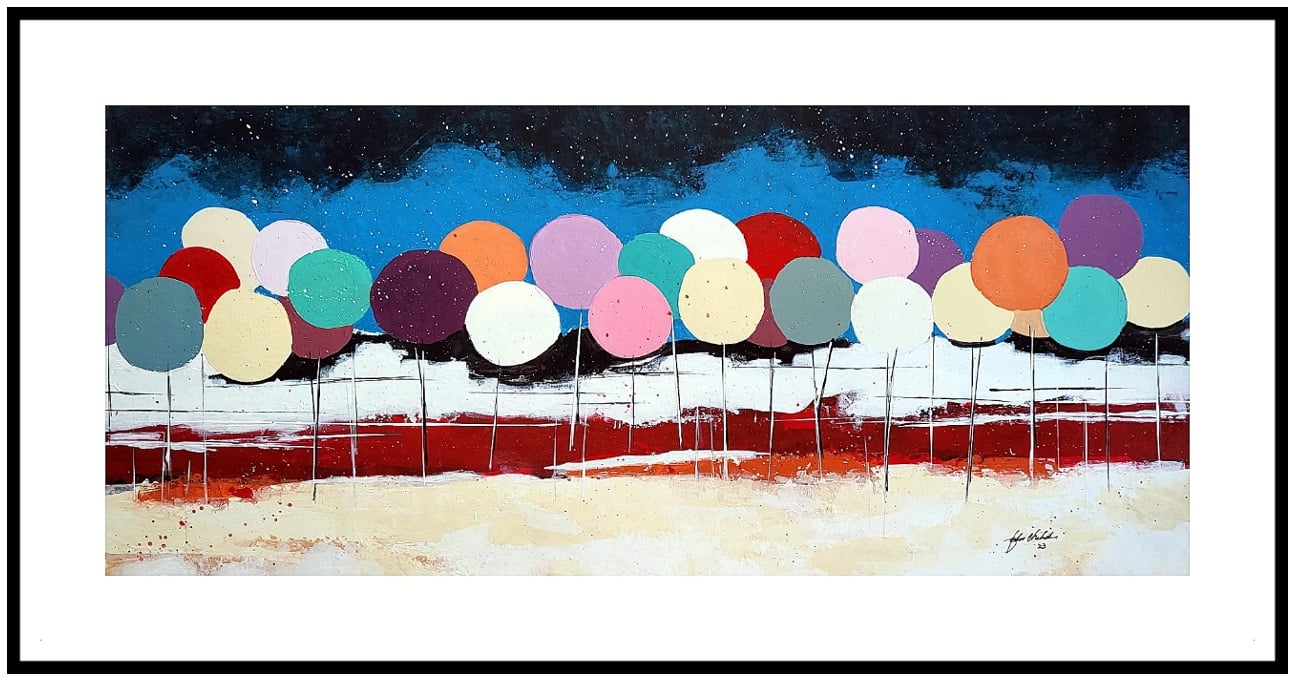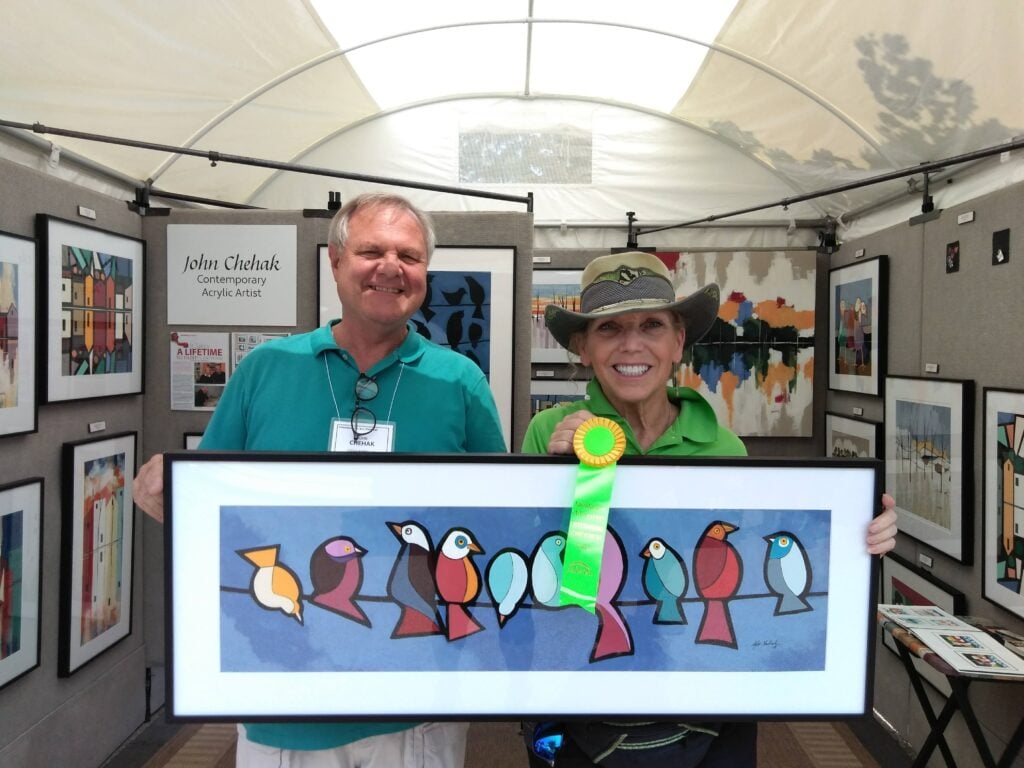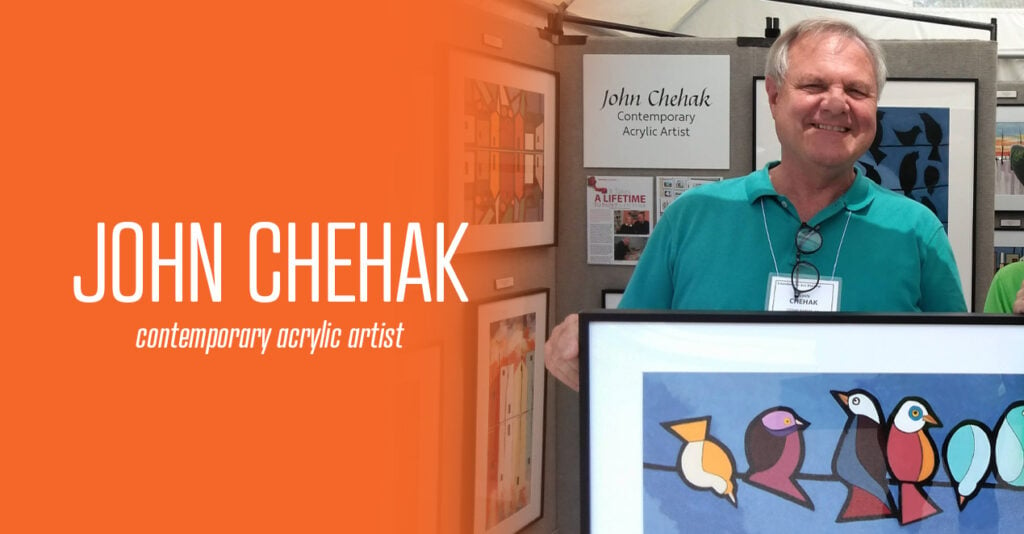Midwest Modern: Meet Contemporary Acrylic Artist John Chehak
When John Chehak graduated with a degree in pharmacy, he couldn’t have guessed that 25 years later he would become a professional artist. Now, as he travels to juried fine art fairs throughout the Midwest, this acrylic artist blends playful, colorful creativity with sensible decisions around framing and production.
Marshmallow Clouds
One magazine editor described John as a “mid-century style artist, a cubist, a minimalist reminiscent of Braque and Picasso.” His vibrant, graphic paintings fit that description well. “The Road Home” (above), from what he calls his “Marshmallow Series,” and “What the Forest Does at Night” (below) both exemplify his talent for simplifying shapes to achieve a distinct look.
Framing Streamlined
John uses acrylic paint on canvas and archival paper. Because his goal is to showcase his paintings without the distraction of multiple frame styles, he has streamlined the framing process. John cuts his own mats and backing board to keep production costs low. “But for the highest accuracy and larger size capabilities, I order all my [framing supplies] from Frame Destination,” says the artist from Cedar Rapids, Iowa.
John has purchased the same frame and mat from Frame Destination since 2012: our slender metal Nielsen Profile 117 in black and our PaperMat Mat Board 4Ply. His glazing of choice is our shatter-resistant Standard Acrylic 1/10 Inch, and when he orders a backing board, it’s our lightweight Regular Foam Mounting Board 3/16 Inch.

See More of John’s Work
Go to John’s website to see his art organized into galleries such as My Birds, Urban Crowding, Landscapes, and Architecture. You can shop prints, original art, a coffee table book, and mugs featuring his work. He also posts his paintings on Instagram. To discover his views on perfectionism and his future professional goals, see my Q&A with John below.

Now for Artie’s Eight Q&A with John Chehak…
1. What is your background; how did you get started?
As a kid, I could always paint or draw, but I never took drawing seriously or considered it a future profession. In the late ’60s and early ’70s, I attended the University of Iowa and, in 1973, received my degree in Pharmacy. That was just the start of many careers. My mother had a severe stroke in 1991, and my father died in 1995 at age 70. Subsequently, I moved into my current home with my two daughters to help care for my mother. I remarried in 1998 to my wife, Deborah. That’s when I started painting professionally. At first, I painted furniture, then switched to paper and canvas. In 1999, Peppertree Studios Art Gallery offered me my first professional show. My paintings at that time were dark in color and tone. Over the years, my style evolved to bold and bright colors of original subject matter. In 2012, my wife and I started selling at regional, juried fine art fairs, and still do. We travel in a 250-mile radius from our home in Cedar Rapids, Iowa, most notably to Minneapolis, Chicago, St. Louis, Evanston, Madison, and other Midwestern cities. I’ve developed a broad range of styles — a little something for everybody. I work hard to create new styles and subject matter. Sometimes, creations are just accidents. I often start with a palette knife and make a simple black line across the middle of the paper. The inspiration follows. People often ask me how long it takes to paint a picture. I refer to Pablo Picasso’s answer: “a lifetime.” Painting is the process and evolution, not the result. The result, to me, is someone enjoying and hanging the painting.
2. What role do you think the artist plays in society?
Artists of all ages provide the public with various emotional triggers: happiness, sadness, anger, envy, admiration, stimulation, encouragement, etc. After 20 years of painting and 13 years of doing regional art fairs, I have learned that everyone has different likes and dislikes with an artistic presentation. It's not a simple yes or no answer to the question, "Do you like this art?" Opinions are not right or wrong. Even professional artists have their favorites and not-so-favorite pieces. From the creativity of subject matter to the selection of media to the choice of tools used, the possibilities are exponential in concept and execution. We truly are all artists, whether we know it or not.
3. What has been a formative experience or the best advice you’ve received within your career?
Try not to be a perfectionist and realize that everyone expresses their artistic capabilities differently. Don't try to paint like anyone else. We all have our own style and capabilities — own yours. Practice does NOT make perfect. It just opens another door.
4. In what ways does your work reflect your personality?
I like to think my artwork is creative and fun to look at. I want to enjoy my own work, and I am overjoyed when someone else likes my art.
5. Creative blocks, do you get them? If so, how do you overcome them?
Of course. Realize that a temporary block means you are simply seeking new creative styles and embellishments.
6. What is your most indispensable tool? (Not counting the obvious, like paints, brushes, canvas, camera, etc.)
My mind.
7. Do you have a new project you are working on, or a new passionate idea?
As I get older, I want to extend my creative reach through various media presentations, art presentations, invitational lectures, and speaking engagements.
8. What is your favorite color to incorporate into your art?
I love all my children.

All artwork and/or photographs used in this post are subject to copyright held by the featured artist.
ARE YOU READY FOR THE SPOTLIGHT? Simply respond to the questionnaire here to apply to be included in an upcoming Artie’s Eight Spotlight.
Last Updated December 20, 2023